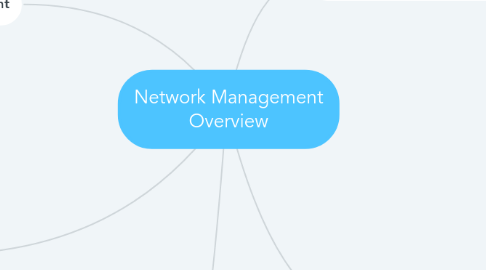
1. Accounting Management
1.1. Controlling of users’ access to network resources through charges
1.2. Individual users, departments, divisions, and even projects are all charged for the network's services.
1.3. Charging does not always imply financial transfer; it could also refer to debiting departments or divisions for budgetary purposes.
1.4. Reasons
1.4.1. It prevents users from monopolizing limited network resources. It prevents users from using the system inefficiently.
2. Security Management
2.1. For controlling access to the network based on predefined policy.
2.2. Security tools such as encryption and authentication can be used.
3. Perfomance Management
3.1. To monitor and control the network to ensure that it is running as efficiently as possible.
3.2. Some protocols, such as SNMP, can be used in performance management to measure performance using some measurable quantity.
3.3. Factor
3.3.1. Capacity
3.3.1.1. Every network has a limited capacity, and the performance management system must ensure that it is not used above this capacity.
3.3.2. Traffic
3.3.2.1. Internally
3.3.2.1.1. Measured by the number of packets (or bytes) travelling inside the network.
3.3.2.2. Externally
3.3.2.2.1. Measured by the exchange of packets (or bytes) outside the network.
3.3.3. Throughput
3.3.3.1. To make sure that it is not reduced to unacceptable levels
3.3.4. Response Time
3.3.4.1. Performance management monitors the average response time and the peak-hour response time.
4. Configuration Management
4.1. Reconfiguration
4.1.1. Hardware Reconfiguration
4.1.1.1. cover all changes to the hardware
4.1.1.2. be specialized personnel trained for quick and efficient hardware reconfiguration.
4.1.1.3. cannot be automated and must be manually handled case by case.
4.1.2. Software Reconfiguration
4.1.2.1. covers all changes to the software
4.1.2.2. software reconfiguration can be automated
4.1.3. User-Account Reconfiguration
4.1.3.1. Not simply adding or deleting users on a system.
4.1.3.2. Must consider the user privileges, both as an individual and as a member of a group.
4.1.3.3. User-account reconfiguration can be, to some extent, automated
4.2. Documentation
4.2.1. Hardware Documentation
4.2.1.1. Maps
4.2.1.1.1. track each piece of hardware and its connection to the network. There can be one general map that shows the logical relationships between subnetworks
4.2.1.2. Specification
4.2.1.2.1. Each piece of hardware also needs to be documented. There must be a set of specifications for each piece of hardware connected to the network
4.2.2. Software Documentation
4.2.2.1. All software must be documented
4.2.3. User-Account Documentation
4.2.3.1. Operating systems have a utility that allows user account documentation.
4.2.3.2. Make sure that the files with this information are updated and secured.
5. Fault Management
5.1. Reactive Fault Managemet
5.1.1. Detecting, isolating, fixing, and recording defects is the responsibility of this unit.
5.1.2. It deals short-term solutions to faults.
5.1.3. Detecting Fault
5.1.3.1. Find the exact location of the fault
5.1.3.2. When a fault occurs, either the system stops working properly or the system creates excessive errors.
5.1.3.3. Example: Communication Medium
5.1.4. Isolating Fault
5.1.4.1. Affect only a few users.
5.1.4.2. The affected users are immediately notified and given an estimated time of correction.
5.1.4.3. .
5.1.5. Correcting Fault.
5.1.5.1. .
5.1.5.1.1. Involve replacing or repairing the faulty components.
5.1.6. Recording Fault
5.1.6.1. The record should include the specific location of the fault, the likely cause, the corrective action or acts taken, the cost, and the time it took to complete each step.
5.2. Proactive Fault Management
5.2.1. Attempts to avoid the occurrence of faults.
5.2.2. some types of failures can be predicted and prevented
